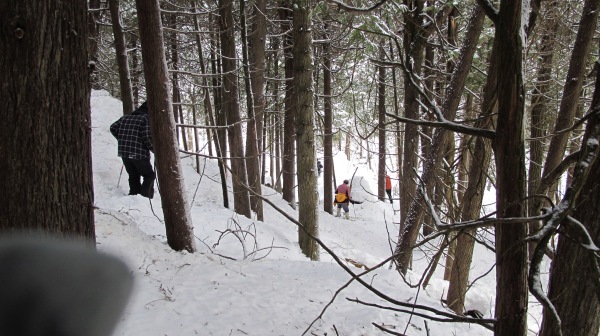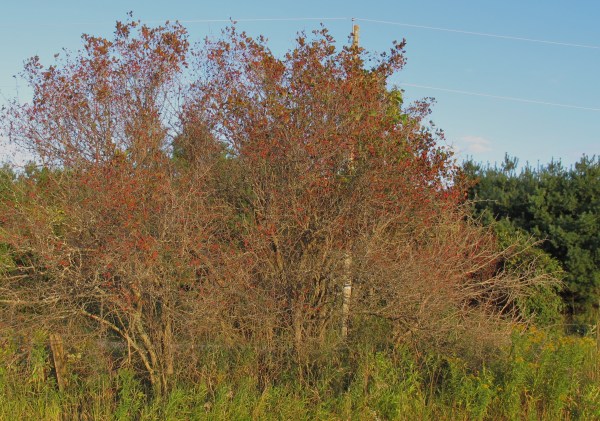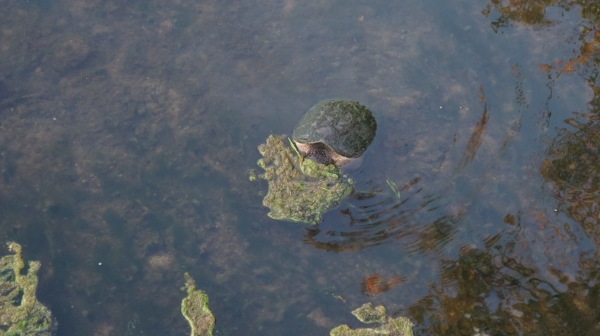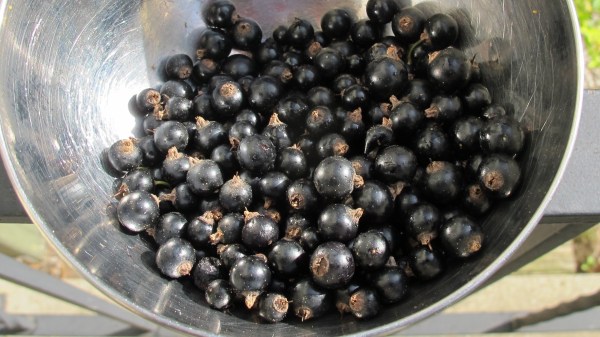crevice hike near Owen Sound

Between errands today I hiked a small and new (to me) stretch of the Bruce Trail just outside of Owen Sound. What a surprise – not as spectacular as Inglis Falls, but a wonderful mix of dolomite crevices, cedar and hardwood forest, and farmland – all packed into three kilometres!



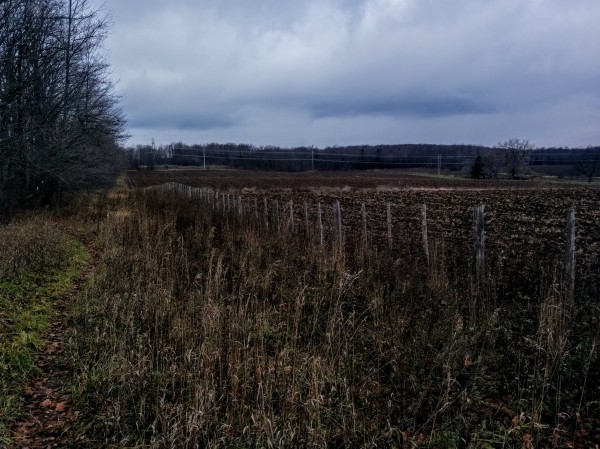
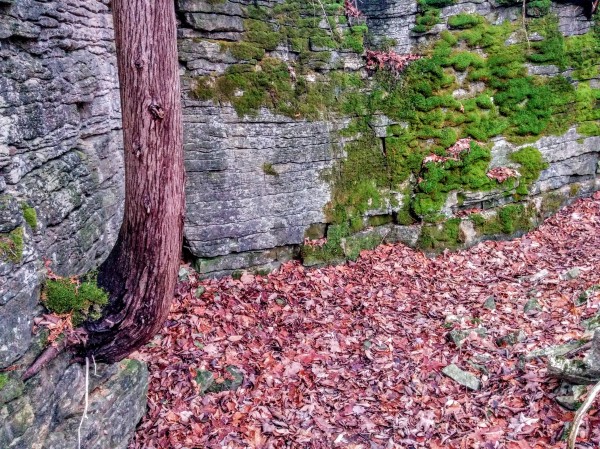
Fall photos….
Owen Sound grain elevator at dawn
Kemble Mountain
Kemble Mountain
Towards Annan
Pamapas
Harry’s Fish Hot Peppers
Four summers ago when my dog, Harry, was still with us I took him to a local vet to deal with some now forgotten malady. In passing the time of day while Harry was checked over we learned we were both gardeners. And like most gardeners, we were eager to compare notes, discuss successes and failures, and share discoveries. On the sharing end of things Harry’s vet provided me with a handful of what he described as Chesapeake Bay Fish Hot Peppers. Purchased the previous season from an on-line heritage seed company, Dr. S extolled their virtues, “lots of flavour, not too much heat, hugely prolific!”
Dr. S proved right on all counts. I’ve been growing these peppers from saved seed each year since and while they don’t for some reason like the soil at the farm, they do great in containers and fantastically in a friend’s garden in Hamilton.
While good used fresh or dried, Harry’s Fish Hot Peppers (gardeners have wide-ranging latitude to substitute names) are at their absolute best when pickled. Here’s a simple recipe that can be adapted to any small hot pepper.
Wash and dry 2 lbs of small hot peppers; slit each pepper length-wise with a sharp knife. Pack the peppers into clean mason jars.
Make a brine by combining 5 cups of white vinegar, 1 cup water, 4 teaspoons pickling salt and 2 teaspoons sugar. Bring the brine to just the boil in a large pot, stirring to ensure the sugar and salt are dissolved. Pour the brine into each jar of pickles leaving a 1/4 inch of head space. Affix the lids to the jars snugly but not over-tight.
Process in a water bath for ten minutes. Remove from bath and tighten lids fully when jars are cool. Wait at least a month before using so flavours can fully develop. Enjoy!
Frozen
A subtle irony this weekend. For the two summers I’ve been here I’ve been saying I must get a boat of some sort to get out on the Sauble River. I would never have imagined the first “voyage” would be on its frozen surface in March! Some pictures from today’s snowshoe…
Groundhog Day Snowshoe Hike
It’s Groundhog Day and in Bruce County, Wiarton Willie is the go-to rodent for spring weather predictions. Willie saw his shadow (meaning six more weeks of winter), but somehow this doesn’t depress me. As mentioned in my last post, the gloom that usually hounds me through the winter months is absent this year. I could just be getting used to the local conditions, but I think it’s a matter of beginning to embrace the season and enjoy it. And a big part of this has been taking up snowshoeing. Some pictures of a hike today at Walter’s Falls.
Do snowshoes actually buoy you up? As a novice, I was skeptical. But taking one off and stepping on the snow, I promptly sank to my knees – they work!
The trail here hugs the mid-slope of the river valley downstream of the Falls, winding through a mixed forest of birch, hemlock and cedar.
A few of these trees, like this hemlock that has succumbed to old age, are remnants of an old growth forest that evaded the logger’s axe into the mid 1900s.
Near the top of the slope looking across the valley…
Winter conditions and the “cumbersomeness” of snowshoes on a downhill course make for some tricky hiking. It will be good to return to the Inn, built on the site of Walter’s Mill, where a hot beverage awaits!
Christmas Week
Chill winter has definitely arrived in Bruce County. But unlike previous winters, it somehow brings cheer rather than gloom and apprehension. Perhaps it’s because we’ve been spared the worst of the freezing rain and power outages of our neighbours to the south. Or perhaps it’s because I’ve got a proper set of snow tires on the car this year. Or perhaps it’s simply that it’s Christmas with loved ones in the house, leftover turkey sandwiches in abundance, and some downtime to enjoy the farm and the beauty of the countryside at this time of year.
The Sauble River, just upstream from the farm. This photo was taken in nearly the exact spot as one that appeared in a post of four months ago. The current here is sufficient to keep the river open throughout most of the winter. Only during the most frigid spells does it freeze over completely.
A female Goldeneye takes off in a panic as I appear over the bridge railing to take her picture. Several of these ducks were sheltering here, likely glad of the calm, open water – a place to access food on the riverbed, and escape the wind and waves of Lake Huron.
High bush cranberries still encased in ice after last week’s freezing rain storm. As mentioned above, this storm swept through much of eastern Canada earlier in the week. Hundreds of thousands of homes were left without electricity and many still have no power today. Somehow, we were mostly spared in Bruce this time, although power outages due to both winter blizzards and summer thunderstorms are common.
“Grey Road 5” looking east towards Owen Sound. These are typical road conditions from December to the end of March. Looking at it now, it’s hard to believe that in summer I commute to work along this route on my bicycle!
The farm down the road from me where I usually buy eggs. The hormones that govern a hen’s egg-laying machinery are highly attuned to light conditions. As a result, egg production drops off drastically during the short days of winter unless the natural daylight is augmented with artificial. My neighbours however forgo the extra light to give the girls a rest during the winter. This sign replaces the usual “eggs for sale”.
By the way, you might be wondering why I’m buying eggs and not eating ones produced by my own hens. The truth is they still managed this year to hide them from me and I simply gave up. In fact as a result, next year’s flock are going to be free-ranged meat birds rather than layers. Happy new year!
Hawthorn Jelly
When I was a kid, we had a hawthorn in our backyard that was large enough to qualify for tree status. Though coarse and infinitely prickly, it provided shade for our play, and food and shelter for a variety of birds (my first Great Horned Owl was observed among the branches of that tree).
I was reminded of this tree last week as I watched a flock of migrating robins feed on the brilliant red fruit of the hawthorns in the hedgerow between my farm and the neighbour’s. Last year, this source of food was absent; a March heat wave followed by a severe frost destroyed the blossoms on most local fruit bearing trees and shrubs. Watching the birds noisily gorge themselves, I wondered if the haws (as the fruits are called) might be made into preserves. In many ways, they resemble crabapples in terms of tartness and texture, a marginal fruit that makes excellent jam and jelly. A quick online search revealed that yes, hawthorn jelly is a not uncommon homemade edible, especially in the UK where hedgerow fruits are revered for both their taste and their heritage. I decided to give it a try…
Three pounds of haws picked from one tree with, remarkably, no impalement of hands or fingers…
The same three pounds stemmed (a tedious task), washed and placed in a large pot…
After simmering for an hour with an added cup of water, placed in a jelly bag to drip overnight…
The next morning, a decision had to be made. None of the recipes I found agreed on the proportion of sugar needed or whether commercial pectin should be added to augment the natural content in the haws. In the end, I went on instinct and did a mash-up of a couple of them: equal proportions of juice to sugar, no commercial pectin, but the addition of 1TBS of lemon juice to boost the natural content. After ten minutes of vigorous boiling, the set test was positive. Note: please don’t rely on these directions – pectin content in the haws can vary with hawthorn species, climate and time of picking!
Success: two jars of not too sweet, amber jelly…..
… with a hint of the hedgerow in them.
Early Morning Countryside
Previous posts have highlighted the natural beauty of the Bruce Peninsula and the Niagara Escarpment that lie just a few a few kilometers north of the farm. However, the local rural countryside, though not perhaps as dramatic as the Peninsula, has its own subtle beauty. This beauty is especially evident on an early morning August ride with a hint of fall in the air….
The Sauble River, just upstream of the farm. Though muddy and slow-moving, it’s a healthy watercourse that supports a diverse wildlife population.
Example: a turtle forages for its breakfast under a clump of floating algae. This beast was nearly the size of a dinner plate – some research will be needed to see if its species can be determined.
Back in the 1800s, when England was granting farm acreages to settlers, most of southern Ontario was carved up into a vast geometric grid of land concessions. As this land opened up, hypothetical grid lines on a map became real access roads, still used today: dead straight and often (though not always) monotonous.
Two horses trot towards me in their pasture, hoping perhaps for a treat. Biting flies have been fierce this year, hence the masks they both wear to protect their eyes (they can see through them). Horses are expensive. They’re “hay vacuums” as my friend says and their vet bills can be enormous. But despite this, the majority of farms seem to keep a few – apparently just for the love of them.
“Farm for Sale” signs are not an uncommon sight up here. The kids of most local farmers have no interest in taking on the family business. So when farmers retire, most properties go up for sale and their fates can vary . Many will be absorbed by existing cash crop operations to produce corn and soy (a.k.a. industrial agriculture). Others though may be bought (or rented) by a trickle of young people interested in small-scale farming, or by the growing Mennonite community.
And speaking of corn and soy, a large field of each hugs a rise of land…
… and a heron departing a roadside pond with its breakfast near these fields reminds me it’s time to return home for mine.
Catching Up
Well, summer is almost over (someone had to say it) and here I am finally with the first post of the season. A serious case of writer’s block was to blame combined with the kind of procrastination stress you suffer when you haven’t called up a friend in a long time (the longer you wait, the more awkward and difficult it gets). But whatever, time to catch up!
The Garden
As gardeners everywhere will acknowledge, each year yields success, failure and surprise, which is part of what makes the process so enjoyable. On the success front, the garlic harvest has been wonderful. Planting the cloves last year where beans (nitrogen fixers) grew the previous season seems to have paid off. The bulbs are big, meaty and flavourful. Some of the healthiest specimens will be set aside to plant this fall for next year’s crop.
The big failure of the year was a preliminary attempt to grow hops, an aromatic vine-growing flower that is used as a flavouring and bittering agent in beer. A friend who is a chemist by day and a home brewer by night suggested that hops would be good to grow. We could use them to make a quality home brew of our own and there was the potential to sell them to local home brew stores and perhaps even micro-breweries. Intrigued, I ordered a hop rhizome on-line back in May for an extortionate price and planted it along a fence line. Checking on it the next day, I found that something had dug it up and enjoyed chewing it into a sodden mass. Not surprisingly, attempts at replanting it were not successful. However, we’ll be back for more next year though this time with some planting protection.
The surprise of the year was a sole black currant bush on the property which I’d given up for dead but offered up a scant cup of precious currants. There should be just enough of them to make one (very) small jar of jam – a treat to open one winter Sunday morning.
Bird Life
For the first time this year I stopped putting feed out for wild birds during the late spring and summer months. Knowing no one was going to go hungry with the abundance of natural food, I was curious to see how the absence of the feeder would affect the local population. And while one summer’s observation can’t be called statistically valid, it does seem there’s been a significant increase in the diversity of species around the farm this year. In the previous summer, we were inundated with a large flock of pretty, though aggressive goldfinches that appeared to intimidate more passive songbird species from appearing. However, birds I hadn’t seen here before, including Eastern Phoebes and Song Sparrows are now a common sight (or sound).
Another new avian visitor this year is the Catbird. Though not uncommon in this area, they have a reputation for being elusive and shy of people. However, the individual in this video has been practically haunting me over the past week when I sit outdoors or work in the garden!
Channelling Elvis through a Stray Hen
One evening last week while I was planting potatoes behind the house, my cell phone rang. It was my neighbour Paul, who lives at the end of the laneway.
“One of your chickens is outside my front door,” he said, “I tried to catch her but she’s too quick.”
Two days earlier, I’d picked up six Rhode Island Red layers. Today was their first day out of the pen to free range and one of them was clearly the adventurous type. I hurried down to Paul’s place, but after five minutes of trying to corner her, we gave up and left her to her ramblings. It’s funny what a little experience brings. Last year with the first bunch of hens, I’d have been frantic if one of them had strayed off the property and would have spent the evening trying to capture her. This year however, I was confident she could be left to figure it out and head home when it began to grow dark (which she did).
Paul decided we needed a restorative after our efforts and invited me in for a drink which I was happy to agree to. Because we both work and Paul’s job involves shifts, we generally only see each other in passing – a wave, a quick remark about the weather. So this was a nice opportunity to sit down and have a bit of a real chat. And as well, I’d heard from another neighbour that Paul has a somewhat unusual hobby which I wanted to ask him about..
As it turned out, I didn’t have to bring up the topic. As soon as we were comfortably settled into chairs with glasses of wine, Paul asked, “so have you ever sung any Karaoke?” I confessed I hadn’t though I had always wanted to get up enough nerve give it a try. “I’ve heard though, Paul that you’re really into it and even do shows.”
“Ah, you’ve been talking to John [another neighbour],” he laughed and motioned with his head to a large photo on top of the TV which I hadn’t noticed before. It was a full length of Elvis in his late Las Vegas period – white sequined suit and boots, jet black hair and enormous sideburns. “”That’s me at last summer’s festival,” he said, “I’ve let my hair go back to gray since. I’m not sure whether to dye it this year or just wear a rug.”
So the rumour was true: my neighbour was an Elvis impersonator. I asked him how he’d got into it. “It all started five years ago when I sang Karaoke at a social night at a work conference I was attending:, he said. “I got hooked immediately, started practising in a serious way and specialized in Elvis whose music I love. And the impersonation thing just followed from that.”
Paul then took down a garment bag that was hanging in a corner of the room and unzipped it. Inside was the white sequined suit that appeared in the photo with the white boots neatly tucked into the bottom. For one awful moment I thought he was going to ask me to try it on. But instead he said, “so enough of this – it’s time for you to give it a try!” He showed me into the next room where he had another huge TV and an enormous sound system plugged into it.
“So what do you want to sing?” he said, leafing through an album of CDs. I confess I was bit disappointed. Pauls’ tastes run toward the crooner style. In my Karaoke fantasy, I saw myself bringing the house down with something like David Bowie’s Heroes. But the selection here ranged from Tony Bennett to Frank Sinatra – not really my thing and very difficult to sing.
“I know,” he said, sensing, my unease, “how about a little Dean Martin? How about Everybody Loves Somebody Sometime? Why not, I thought. It’s pretty simple, can’t be more than two octaves, I should do a good job of it.
However, I didn’t. I couldn’t get the tempo down, or follow the lyrics on the prompter, or carry the tune. It was pathetic, though strangely fun at the same time. “You did very well,” said Paul kindly, “it’s not easy getting all the pieces to work together. I think I’ll do a Roy Orbison tune. It’s good to work with other artists so you don’t get stale.”
He then launched into Pretty Woman. Not a cheesy impersonation of Roy Orbison singing it, but his own interpretation of the song with slightly different phrasing and in his own deeply resonant voice. He was great.
As I was leaving to go be sure the stray hen had in fact made it home, Paul invited me to come see him perform at an upcoming Legion dance. John by the way will also be there – he runs the sound panel at most of Paul’s shows.
I will definitely go. If Paul sings Elvis the way he sings Roy, it will be wonderful.















